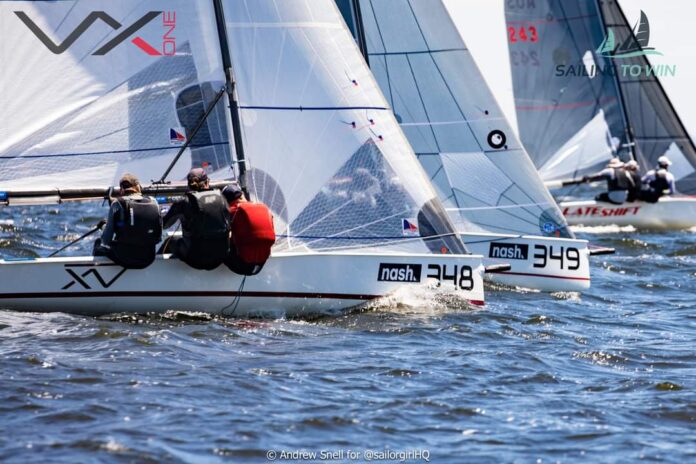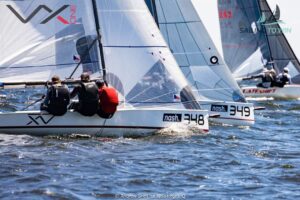

Pre-start intel will have a great bearing on how you will finish in a race. You must get out on the course at least 45 minutes before the starting signal.
The things that you need to do are to make sure you are set up to go fast in the prevailing conditions, work out what is happening with the wind and do your starting line research.
Gather wind readings.
Sail upwind with the speed team, tweaking the rig and sails to get the best speed to match the wind strength and sea state. The tactical team will be working out the wind patterns and recording changes in direction to work out whether the shifts are oscillating or persistent.
Note the range of headings on port and starboard tacks and also determine the timing of shifts. This will help you to work out the mean direction on each tack and will enable the tactician to call tacks and Gybes so you sail the shortest possible distance between marks.
During this upwind fact-finding sail, you should also be taking note of other tactical considerations like current, potential geographic shifts and varying wind conditions across the course.
Set your boat up for speed.
Have a tuning partner and hit the track early with them to compare relative height and speed.
Upwind – If you’re pointing well but not going forward, make your sails flatter. If you have speed but no height, make the sails fuller and tighter leech, especially the main.
If you’re lower and slower, make sure you’re set up according to your sailmaker’s tuning guide. Experiment with different settings, and ask your tuning partner how they’re set up if they’re beating you.
Downwind – Try different sailing angles, crew placement and heel to work out which mode gives you the best VMG. This is where a tuning partner is essential.
The benefit of tuning before the race is that it allows you to gain confidence in your settings and boatspeed. This frees you up to look around while racing. Unprepared sailors have their heads in the boat trying to go fast, and their tactics suffer as a result.
Research the starting line.
Around 15 minutes before the start, begin getting your head in the race. Once the start line is set, commence your start line research and formulate your starting strategy.
Get a line sight by sailing to the end of the line away from the land and sight through the committee boat to an object on the land that is in line with both ends. Then sail down the line using that sight to get comfortable with being on the line.
Sail up the line to work out how long it takes to get to each end and keep an eye on the compass to mentally record the heading.
When the weather mark has been set, note its direction and then do a head to wind on the line to work out the line bias and favoured end.
Don’t be content with doing this once. Be prepared to carry this out continuously up until the start to track changes in wind direction as this will help to determine your race strategy.
One final thing.
Do a brief upwind sail again to see if anything has changed. Check your compass again and make sure the boat still feels right for the conditions. Observe your angle compared to the line.
Visualise how the fleet will come off the line at that angle and factor that into your final game plan. Your angle off the line should correspond to the favoured-end research you did.
If not, then there’s either been a shift or the committee moved the line. Be prepared to re-jig your game plan.

